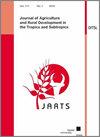Effects of three leafy vegetables on the growth performance of Giant African Snail Achatina (Lissachatina) fulica
Q3 Social Sciences
Journal of Agriculture and Rural Development in the Tropics and Subtropics
Pub Date : 2019-06-07
DOI:10.17170/KOBRA-20190219195
引用次数: 2
Abstract
This present research was performed to evaluate the effects of three leafy vegetable diets [bitter leaf ( Vernonia amygdalina ), fluted pumpkin leaf ( Telfairia occidentalis ) and pawpaw leaf ( Carica papaya )] on the growth performance of Giant African Snail ( Achatina fulica ). A total of ninety (90) A. fulica were used for the study. Thirty (30) snails each were subjected to three different dietary treatments in three replicates of 10 snails per replicate and fed with the fresh leaves of these vegetables over a period of 12 weeks. Results obtained recorded no significant differences ( P > 0.05) in terms of weight gain, shell length, shell circumference and shell thickness. On the whole, A. fulica fed on T. occidentalis leaf performed better in terms of mean weight gain when compared with those fed on V. amygdalina and C. papaya leaves . Conversely, snails fed on C. papaya leaf had the best mean shell length gain, mean shell circumference and mean shell thickness when compared with those fed on V. amygdalina and T. occidentalis leaves. The study clearly showed that the tested vegetables can be successfully utilised as diets for rearing of A. fulica . For farmers to achieve optimum productivity, Telfairia occidentalis and Carica papaya leaves are recommended in the dietary menus of snails while bitter leaf can successfully serve as an alternative to the other leaves.三种叶类蔬菜对非洲巨型蜗牛生长性能的影响
本研究旨在评价三种叶菜日粮[苦叶(Veronia amygdalina)、南瓜叶(Telfortusa occidentalis)和木瓜叶(Carica木瓜)]对非洲巨蜗牛(Achatina fulica)生长性能的影响。共使用了九十(90)株黄曲霉进行研究。三十(30)只蜗牛分别接受三种不同的饮食处理,每次重复10只蜗牛,并用这些蔬菜的新鲜叶子喂养12周。所得结果无显著差异(P > 0.05)。总的来说,与食用苦杏仁和番木瓜叶相比,食用西葫芦叶的黄颡鱼在平均增重方面表现更好。相反,以番木瓜叶为食的蜗牛的平均壳长、平均壳周长和平均壳厚与以苦杏仁和西洋田螺叶为食相比最好。研究清楚地表明,试验蔬菜可以成功地用作饲养黄颡鱼的日粮。为了让农民获得最佳生产力,蜗牛的饮食菜单中推荐使用西葫芦和番木瓜叶,而苦叶可以成功地替代其他叶子。
本文章由计算机程序翻译,如有差异,请以英文原文为准。
求助全文
约1分钟内获得全文
求助全文
来源期刊
CiteScore
2.30
自引率
0.00%
发文量
0
审稿时长
>36 weeks
期刊介绍:
The Journal of Agriculture and Rural Development in the Tropics and Subtropics publishes papers dealing with original research and review papers in the fields of plant production, animal nutrition and animal husbandry, soil science, rural economy and farm management, forestry and forest economy, veterinary hygiene and protection against epidemics.

 求助内容:
求助内容: 应助结果提醒方式:
应助结果提醒方式:


